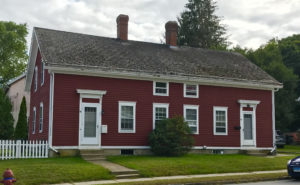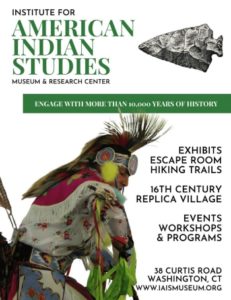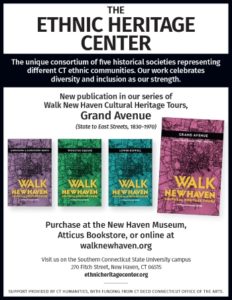By Mary M. Donohue
(c) Connecticut Explored Inc., Winter 2022-23
Subscribe/Buy the Issue!
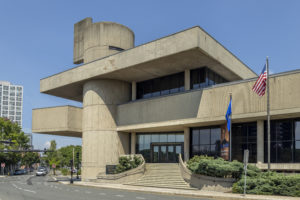
Michael McGivrey Pilgrimage Center and Museum (1965), 1 State St, New Haven. Designed by Douglas Orr, deCossy, Winder & Assoc. The Knights of Columbus were founded in New Haven by son of Irish immigrants Father Michael J. McGivrey (1852-1890). Photo credit: Robert Gregson
Mathew Lyon (1749-1822) came to Woodbury from Ireland in 1764 at age 15 as a “redemptioner” agreeing to be “sold” on his arrival as an indentured servant to pay for his passage. He later served in the United States Congress as a representative from both Vermont and Kentucky. Catherine M. Flanagan (1888-1927), native of Hartford and first-generation Irish American, was arrested in 1917 in front of the White House picketing in favor of women’s suffrage. She later was selected to carry the document certifying Connecticut’s ratification of the 19th amendment to Washington, D.C. in 1920. In 1882, Father Michael McGivney (1852-1890) organized a Catholic fraternal mutual-aid society, the Knights of Columbus, that now has more than a million members. All these stories and more are found on the Connecticut Irish-American Heritage Trail website.
Scotch-Irish, famine Irish, lace-curtain Irish, shanty Irish: the Irish Diaspora has shaped Connecticut’s European settlement history almost from the beginning. The Connecticut Irish-American Historical Society traces Irish history and culture in the state not only through its archival and artifact collections but also through the historic buildings, neighborhoods, and cemeteries that stand across the state. Whether they were immigrants, expatriates, refugees, or indentured servants when they arrived from Ireland, almost 19 percent of Connecticut’s current residents claim Irish ancestry, according to Kathleen Hunter on the State of Connecticut Department of Education website The Irish: The Great Hunger and Irish Immigration to America.
The Connecticut Irish-American Heritage Trail website highlights the places where this history happened. The website features sections devoted to history, secular and religious structures, monuments, parades, events, and societies and clubs. Written by historians Lucas Karmazinas and Tod Bryant and sponsored by the Connecticut Irish-American Historical Society, the site has more than 100 entries filled with information and photographs.
Some of the sites featured reflect sheer determination and back-breaking manual labor. For instance, the entry for the Enfield Canal (1827-1829) notes that “Over four hundred Irish immigrant laborers, many with families, came to Windsor and Suffield, Connecticut to construct the canal. The work was done entirely by hand, using only pick and shovel, and the earth was carried off with wheelbarrows. The immigrant laborers were poorly paid. The arrival of the Irish canal workers marked the beginning of a substantial ethnic presence in Connecticut.” Or the Taft Railroad Tunnel in Lisbon, dug by Irish railroad workers as part of the Norwich and Worcester Railroad. It allowed the line to hug the river as it worked its way through northeastern Connecticut. Work on the tunnel required Irish laborers equipped with picks and shovels to slowly chip their way through solid rock. The tunnel, completed in 1837, is 300 feet long, 23 feet wide, and 18 feet high.
Mills that produced textiles, guns, buttons, and more employed Irish workers, male and female.
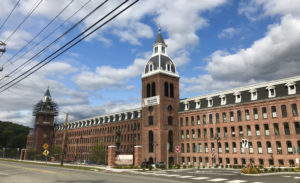
Ponemah Mill (1866-1871), 607 Norwich Avenue, Taftville. Irish workers constructed this large textile mill and later became mill workers in Taftville, a company-built and owned mill village. Photo credit: Mary Donohue
A prominent example included on the site is the manufacturing village of Taftville, located in Norwich, where the large Ponemah Mill complex was established to produce high-end cotton cloth during the late 1860s. Built by Irish laborers between 1866 and 1871, the mills became an important source of employment for immigrants, many of whom lived in corporation-built housing nearby. A similar example can be found along the Shetucket River just two miles south of the Ponemah Mills in the village of Greeneville, where a number of paper and cotton mills were established during the 1830s and 1840s.

St. John Roman Catholic Church (1852), 19 St. John’s Square, Middletown. Beginning in the 1840s, hundreds of Irish immigrants became low-paid workers in the Portland brownstone quarries. Brownstone became a hugely popular building material here, in New York City and beyond. St. John’s was designed by Irish-born architect Patrick C. Keely (1816-1896), designer of several hundred Roman Catholic churches and was built to serve the Irish immigrant community in Middletown. Photo credit: Mary Donohue
Many buildings illustrated on the website were designed by Irish-born architects. George Keller (1842-1935) born in Cork, emigrated to New York City in 1853. After working in several architectural firms, Keller accepted a job in Hartford and became the city’s leading 19th-century architect, according to David F. Ransom in George Keller: Architect (Harriet Beecher Stowe Center, Hartford, 1978). His most beloved structure may be Hartford’s Soldiers & Sailors Memorial Arch (1886) in Bushnell Park. Architects James Murphy (1834-1907), born in Tipperary, and Patrick C. Keely (1816-1896), born in Kilkenny, individually and in practice together designed several hundred Roman Catholic churches in the United States, according to David F. Ransom in Biographical Dictionary of Hartford Architects (The Connecticut Historical Society Bulletin, Winter/Spring 1989, vol. 54), with many outstanding examples in Connecticut.
Roman Catholic churches, convents, rectories, and parochial schools that served Irish parishioners or were staffed by Irish religious orders are located throughout the state. These buildings represented a statement to the wider community that the Irish had “arrived” and had the financial strength to erect an architect-designed building, often of brick or stone, as shown in the website illustrations. Many have been used for several generations. Significant landmarks in their neighborhoods, these properties can be at risk for demolition due to dwindling congregations.
Immigrant communities often created places to socialize. Irish fraternal societies such as the Knights of Columbus, Hibernian Provident Society, Sons of Erin, and the Knights of St. Patrick all had meeting halls. Social clubs also exist to help foster an appreciation of Irish history and culture through classes in language and dance and by sponsoring sports teams.
Among the success stories the website highlights is Rock Ledge Mansion (1913), a Tudor Revival-style summer estate belonging to James Augustus Farrell Sr. (1863-1941). Farrell, born in New Haven to Irish immigrant parents, became the president of U.S. Steel, holding that position from 1911 to 1932.
But the website’s audience is not limited to those with a claim to Irish ancestry. Many historic sites and buildings have multiple layers of history. Hartford’s Soldiers and Sailors Memorial Arch, designed by an Irishman, is also on the Connecticut Freedom Trail, the state’s Black history trail, for its depiction of a Black man breaking the chains of bondage and for a marker added in 1988 noting the contributions of African Americans to the Civil War.
Mary M. Donohue is an architectural historian, preservationist, and retired assistant publisher of Connecticut Explored.
EXPLORE!
The Connecticut Irish-American Heritage Trail, https://www.ctirishheritage.org/
The Connecticut Irish-American Historical Society is based at New Haven’s Ethnic Center, 270
Fitch Street, New Haven. https://www.ctirishhistory.org/
Connecticut Explored has published these articles on the Irish community.
Read more at
https://www.ctexplored.org/sample-article-connecticuts-irish-domestics/
https://www.ctexplored.org/a-fortress-for-faith-based-advocacy-the-knights-of-columbus/
https://www.ctexplored.org/one-governor-two-rivers-an-irish-fish-and-a-movie-star/
https://www.ctexplored.org/east-havens-wildest-irish-rose/
https://www.ctexplored.org/architect-kevin-roche-shaping-environments/
https://www.ctexplored.org/eugene-oneill-new-londons-monte-cristo-cottage/

